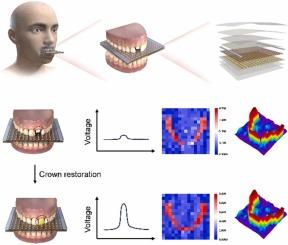当前位置:
X-MOL 学术
›
Nano Energy
›
论文详情
Our official English website, www.x-mol.net, welcomes your
feedback! (Note: you will need to create a separate account there.)
A flexible self-powered occlusal force sensor array for assisting oral occlusion reconstruction
Nano Energy ( IF 16.8 ) Pub Date : 2024-11-12 , DOI: 10.1016/j.nanoen.2024.110466 Hao Yu, Wentao Cao, Wen Han, Wenjin Li, Yuan Gao, Yaqi Zhang, Feng Chen, Shengcai Qi
Nano Energy ( IF 16.8 ) Pub Date : 2024-11-12 , DOI: 10.1016/j.nanoen.2024.110466 Hao Yu, Wentao Cao, Wen Han, Wenjin Li, Yuan Gao, Yaqi Zhang, Feng Chen, Shengcai Qi

|
Occlusal force is increasingly being recognized as a key parameter for evaluating masticatory motor dysfunction and the effectiveness of dental management in patients. However, the evaluation of occlusal force lacks objective quantitative assessment and reliable monitoring techniques. Here, a flexible self-powered sensor array is proposed for real-time monitoring occlusal force to further assist in oral occlusion reconstruction. Employing the triboelectric nanogenerator technology, the battery-free sensor succeeds in effectively capturing static and dynamic occlusal forces from teeth and converting them into accurate and quantitative electrical signals. With an average sensitivity of 0.72 volts per Newton and a response time of 15 ms, the sensor features excellent synchronicity in electro-mechanical conversion and durability. Furthermore, the sensor array, based on complementary semicircular electrodes (15 × 15 pixels), enables the construction of visualized electrical signals mapping, which can reflect the intensity and location of occlusal force. The patterned electrical signal distribution can then be analyzed by researchers, providing a quantitative reference for clinical crown restoration. We expect this self-powered sensor array to enrich the approaches of occlusal force detection and provide valuable assistance for the reconstruction of oral occlusion.
中文翻译:

一种用于辅助口腔闭塞重建的柔性自供电咬合力传感器阵列
咬合力越来越被认为是评估咀嚼运动功能障碍和患者牙科管理有效性的关键参数。然而,咬合力的评估缺乏客观的定量评估和可靠的监测技术。在这里,提出了一种灵活的自供电传感器阵列,用于实时监测咬合力,以进一步协助口腔咬合重建。采用摩擦纳米发电机技术,无电池传感器成功有效捕获牙齿的静态和动态咬合力,并将其转换为准确和定量的电信号。该传感器的平均灵敏度为 0.72 伏/牛顿,响应时间为 15 毫秒,在机电转换方面具有出色的同步性和耐用性。此外,基于互补半圆电极(15 × 15 像素)的传感器阵列能够构建可视化的电信号映射,从而反映咬合力的强度和位置。然后,研究人员可以分析图案化的电信号分布,为临床牙冠修复提供定量参考。我们期待这种自供电传感器阵列能够丰富咬合力检测的方法,并为口腔咬合的重建提供有价值的帮助。
更新日期:2024-11-12
中文翻译:

一种用于辅助口腔闭塞重建的柔性自供电咬合力传感器阵列
咬合力越来越被认为是评估咀嚼运动功能障碍和患者牙科管理有效性的关键参数。然而,咬合力的评估缺乏客观的定量评估和可靠的监测技术。在这里,提出了一种灵活的自供电传感器阵列,用于实时监测咬合力,以进一步协助口腔咬合重建。采用摩擦纳米发电机技术,无电池传感器成功有效捕获牙齿的静态和动态咬合力,并将其转换为准确和定量的电信号。该传感器的平均灵敏度为 0.72 伏/牛顿,响应时间为 15 毫秒,在机电转换方面具有出色的同步性和耐用性。此外,基于互补半圆电极(15 × 15 像素)的传感器阵列能够构建可视化的电信号映射,从而反映咬合力的强度和位置。然后,研究人员可以分析图案化的电信号分布,为临床牙冠修复提供定量参考。我们期待这种自供电传感器阵列能够丰富咬合力检测的方法,并为口腔咬合的重建提供有价值的帮助。


















































 京公网安备 11010802027423号
京公网安备 11010802027423号